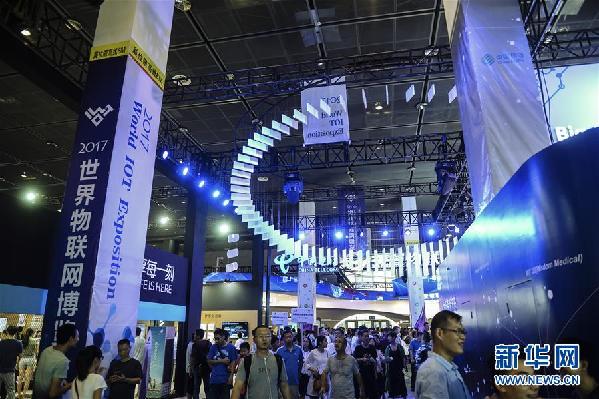


2017 World Internet of Things Expo is held in Wuxi on Sept. 10, 2017.
China’s Internet of Things (IoT) industry saw its output value reach 950 billion yuan ($146 billion) in 2016, a senior official said during an IoT Expo in Wuxi, east China’s Jiangsu province, where a lot of cutting-edge technologies, such as unmanned shops, self-driving vehicles, smart clothing, and smart hosting were on display.
The IoT industry offers a new vision for medical treatments and healthcare. For example, it is now possible for a patient to send his or her health data to their personal doctors so that they can quickly be informed what medicine to take.
China’s NarrowBand IoT, an important branch of the industry, has taken the lead in many areas. “With a new alternative provided by IoT, fewer people will go to the hospital in future,” said deputy director of a hospital in Wuxi.
IoT will bring about other changes to people’s life as well, including helping relieve traffic congestion, assisting supervision work, as well as promoting industrialization and urbanization, according to industry insiders.
The technology will also help monitor environmental pollutants. For instance, the Taihu Lake in Wuxi is closely monitored by 23 stations, 18 floating signs, and other sensors, which transfers data to computers, helping those who monitor its environment to take needed action.
China’s IoT network is mainly concentrated in four regions, including the areas surrounding the Bohai Sea, the Yangtze River Delta, the Pearl River Delta, as well as the country’s central and western regions.
However, insiders warn about weaknesses in core technology and software, as well as lack of talents and an industry standard system, all of which they suggest could be changed by better planning, cultivating more talents, and cutting costs.
 Fire brigade in Shanghai holds group wedding
Fire brigade in Shanghai holds group wedding Tourists enjoy ice sculptures in Datan Town, north China
Tourists enjoy ice sculptures in Datan Town, north China Sunset scenery of Dayan Pagoda in Xi'an
Sunset scenery of Dayan Pagoda in Xi'an Tourists have fun at scenic spot in Nanlong Town, NW China
Tourists have fun at scenic spot in Nanlong Town, NW China Harbin attracts tourists by making best use of ice in winter
Harbin attracts tourists by making best use of ice in winter In pics: FIS Alpine Ski Women's World Cup Slalom
In pics: FIS Alpine Ski Women's World Cup Slalom Black-necked cranes rest at reservoir in Lhunzhub County, Lhasa
Black-necked cranes rest at reservoir in Lhunzhub County, Lhasa China's FAST telescope will be available to foreign scientists in April
China's FAST telescope will be available to foreign scientists in April "She power" plays indispensable role in poverty alleviation
"She power" plays indispensable role in poverty alleviation Top 10 world news events of People's Daily in 2020
Top 10 world news events of People's Daily in 2020 Top 10 China news events of People's Daily in 2020
Top 10 China news events of People's Daily in 2020 Top 10 media buzzwords of 2020
Top 10 media buzzwords of 2020 Year-ender:10 major tourism stories of 2020
Year-ender:10 major tourism stories of 2020 No interference in Venezuelan issues
No interference in Venezuelan issues
 Biz prepares for trade spat
Biz prepares for trade spat
 Broadcasting Continent
Broadcasting Continent Australia wins Chinese CEOs as US loses
Australia wins Chinese CEOs as US loses